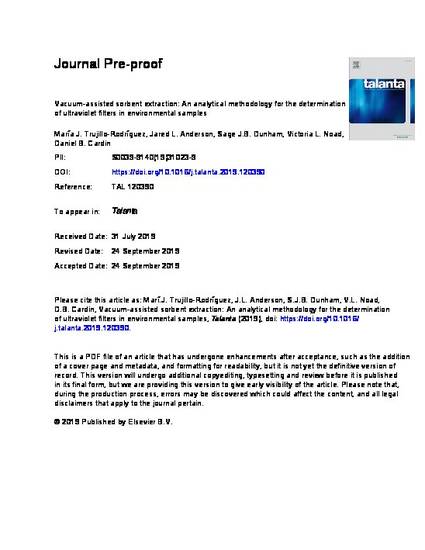
Vacuum-assisted sorbent extraction (VASE) has been applied for the first time in the determination of UV filters in water samples in combination with gas chromatography-mass spectrometry. VASE is a variant of headspace extraction which was developed in conjunction with the sorbent pen (SP) technology. This technique combines the advantages of both stir-bar assisted extraction and headspace solid-phase microextraction. The SP traps allowed both reduced pressure in-vial extraction and direct thermal desorption via a unique gas chromatographic injection port. The main parameters that affect the performance of VASE, including both extraction and desorption conditions, were extensively optimized. Under optimum conditions, extraction required 10 mL of sample within 40 mL vials, pH 3.5, ∼30 s of air-evacuation, 14 h incubation at 70 °C, stirring at 200 rpm, and a final water management step conducted at ∼ −17 °C for 15 min. Optimal thermal desorption required preheating at 260 °C for 2 min followed by desorption at 300 °C for 2 min. The beneficial effect of reduced-pressure extraction was demonstrated by comparing the UV filter extraction time profiles collected using VASE to an analogous atmospheric pressure procedure, resulting in up to a 3-fold improvement under optimized conditions. The VASE methodology enabled simultaneous extractions using different SPs without compromising the method reproducibility, which increases the overall sample throughput. The method was characterized by low limits of detection, from 0.5 to 80 ng L−1, and adequate reproducibility, with inter-SP and inter-day relative standard deviation lower than 14%. Tap and lake water was successfully analyzed with the proposed methodology, resulting in relative recoveries of spiked samples ranging between 70.0 and 120%.
Available at: http://works.bepress.com/jared_anderson/38/

This is a manuscript of an article published as Trujillo-Rodríguez, María J., Jared L. Anderson, Sage JB Dunham, Victoria L. Noad, and Daniel B. Cardin. "Vacuum-assisted sorbent extraction: An analytical methodology for the determination of ultraviolet filters in environmental samples." 208 Talanta (2019): 120390. DOI: 10.1016/j.talanta.2019.120390. Posted with permission.